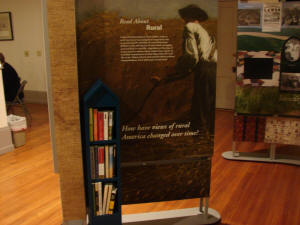|
Smithsonian’s traveling exhibit
“Crossroads: Change in Rural America” meshes perfectly with
Atlanta’s historical works on education and its impact
Now open - A must see
 Send a link to a friend
Send a link to a friend
 [February 04, 2019] [February 04, 2019]
You don’t have to travel to Washington D. C. to view treasures of
the Smithsonian Museum. The second floor exhibit space of the
Atlanta Museum in historic Union Hall is now filled with a unique
presentation as part of Smithsonian’s nationwide outreach ‘Museum on
Main Street.’
Every two years the Smithsonian creates a traveling exhibit that
brings major themes to small museums across the country. The exhibit
currently housed in the Atlanta Museum is entitled “Crossroads:
Change in Rural America.”
One aspect of being selected to receive the Smithsonian exhibit is
the requirement that the host community create a companion display
that intersects with the Smithsonian traveling display.
Atlanta residents, museum and library personnel brainstormed for a
year and came up with a locally pertinent exhibit entitled
“Classroom and Community: Changes in Rural America’s Sense of
Community.”
Atlanta did not know until recently what the theme of the
Smithsonian exhibit would be, but it seems the two parts of history
meld beautifully.
Atlanta’s rural history and the flow of education from one room
rural schoolhouses that were a staple of Logan County education for
decades to a consolidated school system, Olympia Community Unit
School District 16, fits perfectly with the theme of change that the
Smithsonian exhibit stresses.
“We have been planning for over ten years to host a Smithsonian
traveling museum. Our recent partnership with Illinois Humanities
and their contacts at the Smithsonian produced the perfect
opportunity to apply for a Museum on Main Street display,” said
Atlanta Museum Director Rachel Neisler.
The Smithsonian has several exhibits touring the country, and the
selection of Illinois to host “Crossroads” could not have been
better.
“With the Illinois Bicentennial and Atlanta’s rural history, we
could not have asked for a better theme for the Atlanta Museum. It
spoke to Atlanta’s history,” commented Rachel.

The “Museum on Main Street” themes are changed approximately every
two years and one state is selected to host it. Within the state,
communities vie for the honor of hosting the exhibit. Within
Illinois, seventeen communities applied for this exhibit and six
finalists were selected. Atlanta was one of those.

Some heavy lifting was necessary to get the “Crossroads” exhibit to
Atlanta. Each community is required to travel to the exhibit’s prior
location, disassemble it, transport and set it up in their own
space.
Last Tuesday, Rachel Neisler and her volunteer team traveled to
Shelbyville and packed the exhibit in fifteen specially designed
cases, lifted them into a large truck, returned to Atlanta and set
up the display on the second floor of the Atlanta Museum.
“Believe me, those cases were very heavy,” said Neisler with a
laugh.
The display will be available for viewing until mid-March when
Marshall County has the task of taking the Smithsonian portion down
and moving it to their community.

The Smithsonian exhibit is fascinating. It is a pictorial and
audio/visual tour of early days America and how the hardships and
joys of rural life shaped the country. Its many themes are displayed
at numerous kiosks, each focusing on an aspect of rural life.

Wandering through the exhibit and you will be transported back to
days when perseverance in the face of the harsh realities of rural
life created a community of hardy citizens.

Learn how the widely spread residents of rural America, and of
course Logan County, interacted with their far flung neighbors.
[to top of second column] |


Peruse a small library where books from noted authors describe the
land and its people.
Gaze at an art exhibit that captures the soul of rural America.
Hear and see interviews of those who lived the life of rural
America.
The exhibit is a creative and flowing history lesson that draws the
visitor in. Come get lost in the world of rural America.

The Atlanta exhibit
Volunteers from Atlanta created the companion exhibit “Classroom and
Community: Changes in Rural America’s Sense of Community.”

The display follows the arc of education in Atlanta and surrounding
townships. In the 1850’s one room schoolhouses were built within two
miles of every family with school age children. Later students were
sent to large magnet schools in surrounding communities. The final
iteration of educational journey is the consolidated school district
represented by present day Olympia School District.
“It took a year of thinking about this theme to finally come up with
the mission statement of what we wanted to do,” said former Atlanta Library
and Museum board member Bill Thomas.
The transition from the Smithsonian exhibit designed by national
museum professionals to the Atlanta display, which was designed by
volunteers from Atlanta and the surrounding area, is seamless. The
Atlanta exhibit is every bit as informative and transfixing as the
Smithsonian exhibit.
The Smithsonian exhibit is a macro view of rural American, while the
Atlanta presentation telescopes in for a micro view of life and
education in the history or our own small rural area.
Volunteers for the Atlanta exhibit fanned out in town and rural
Logan County to interview those who lived the education passage in
rural America and collected mementos from school days that had been
stored away for decades.

Each station focuses on an aspect of education in rural Atlanta that
formed the lives that created a community, and how that community
changed as the educational system changed.
The two exhibits currently on display at the Atlanta Museum are
absolutely worth a visit. You’ll want to take the time to go there
and become immersed in our shared history.
Another event occurred Friday evening during the initial viewing of
the exhibits. The first floor of the Union Building is being turned
into a visitor’s center for those traveling through Atlanta.
Just minutes before the Friday evening event commenced, a mural on
the walls of the visitor center was unveiled. It depicts the history
of Atlanta and covers much of the wall space. It is spectacular.

Artist Regan King of Normal is responsible for the new work. Ms.
King was selected as the muralist after Atlanta Library Director
Cathy Maciariello reached out to a friend in the Bloomington/Normal
arts community for a recommendation.
King took to her commission with unbridled enthusiasm and presented
a volunteer committee from Atlanta with her idea. Thus began a
collaboration that resulted in six reformulations of King’s original
idea. The final design brought the artist together with the Atlanta
residents to create lasting friendships and a wonderful visual
history of their town.
“We had a wonderful time working with Regan. She was open to our
suggestions of where we wanted the art to go,” said volunteer Susan
Hoblit. After sketching the finished work on the walls, a call went
out for volunteers to become artists themselves and fill in the
lines with paint. People who said they could not paint a wall in
their home gathered with Regan King and completed a true work of
art.
The finished mural can be seen through the front window of the
visitor center as a person drives down old Route 66. Stop in and see
the colors and ribbons that convey a sense of community. And
remember, one artist and numerous amateurs created the work of art.
Volunteers who take pride in their community are the Atlanta way.
The Smithsonian exhibit and Atlanta companion display is open
Thursday through Saturday from 10 a.m. to 3 p.m., and Sunday from
noon to 3 p.m. through March 16.
[Curt Fox] |